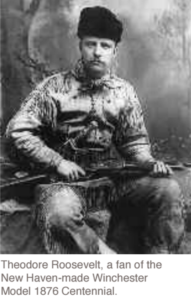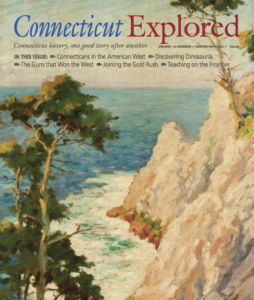By Leah S. Glaser
(c) Connecticut Explored, Inc. Winter 2016-2017
Subscribe/Buy the Issue!
Connecticut Explored invited CCSU history professor Leah S. Glaser to write this issue’s column about this issue’s theme “Connecticans in the American West.”
Last summer, Connecticut Senator Chris Murphy staged a high-profile filibuster demanding the passage of gun control legislation and moved his Hartford office to the site of the Colt Factory. The Connecticut delegation possesses tremendous gravitas on this issue, and not just due to the Sandy Hook tragedy: Connecticut’s gun manufacturing industry has armed the nation since the Civil War.
But even many well versed in the state’s history do not realize the state’s influence on western expansion. Quite simply, the broader industrial activity seen in Connecticut at the end of the 19th century directly fueled western expansion. Connecticut supplied guns, of course. But it also provided products, funding, ideas, and its people to develop what Easterners viewed as a frontier.
 As a historian of the American West teaching students at a public university in Connecticut, I often try to emphasize continuity with the West, a region that most of my students have never seen. Connecticut was involved in the exploration, economic growth, and settlement of the West in myriad ways (only some of which we address in this issue). These include the story of Connecticut’s Western reserve (See “West of Eden,” Summer 2007), Catherine Beecher’s training of teachers and Cornwall’s training of missionaries to help “civilize” the new lands, participation in the Gold Rush, the flooding of communities to secure urban water supplies, and even the management of public lands, specifically forest and parks. These examples illustrate connections between people, economies, and policies that break traditional regional boundaries of New England. Connecticut was heavily complicit in shaping the way the western region of the United States developed and its eventual annexation into the nation.
As a historian of the American West teaching students at a public university in Connecticut, I often try to emphasize continuity with the West, a region that most of my students have never seen. Connecticut was involved in the exploration, economic growth, and settlement of the West in myriad ways (only some of which we address in this issue). These include the story of Connecticut’s Western reserve (See “West of Eden,” Summer 2007), Catherine Beecher’s training of teachers and Cornwall’s training of missionaries to help “civilize” the new lands, participation in the Gold Rush, the flooding of communities to secure urban water supplies, and even the management of public lands, specifically forest and parks. These examples illustrate connections between people, economies, and policies that break traditional regional boundaries of New England. Connecticut was heavily complicit in shaping the way the western region of the United States developed and its eventual annexation into the nation.
While many of the essays in this issue imply the heavy influence of Connecticut on the American West, the stories about environmental conservation, teacher training, and missionary work also indicate that the West pushed back. The region was not the uninhabited and uncivilized place that dime novels and Buffalo Bill’s Wild West show (which made many trips to Connecticut; see “Rediscovering Albert Afraid-of-Hawk,” Summer 2014) advanced. In many ways, the state’s involvement continued the colonial policies of the 17th century, intending to bring New England values to a new region.
But the differences in the regions’ native peoples, cultures, landscapes, and diverse demographics challenged Eastern assumptions about culture and science, which they based on their own local experience and observations. People from Connecticut learned much from their Western experiences, bringing experiences, ideas, and lessons back to our state.
On behalf of Connecticut Explored, I hope you’ll enjoy these stories about Connecticans in the American West. For more stories about Connecticut’s influence outside the state’s borders, see Winter 2011-2012, “Connecticans Abroad,” ctexplored.org/back-issues-winter-20112012/.
Leah S. Glaser is an associate professor of history and public history at Central Connecticut State University, where she teaches courses about the history of the American West.

